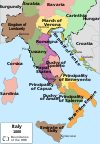Theodahad
| Theodahad | |
|---|---|
| King of the Ostrogoths | |
 | |
| Reign | from 534 to 536 |
| Predecessor | Athalaric |
| Successor | Witiges |
| Born | c. 480 Tauresium |
| Died | 536 |
| Spouse | Gudeliva |
| Issue | Theodegisclus, Theodenantha[1] |
| Mother | Amalafrida |


Theodahad, also known as Thiudahad (Template:Lang-la; born c. 480 AD in Tauresium[2] – died 536) was king of the Ostrogoths from 534 to 536 and a nephew of Theodoric the Great through his mother Amalafrida.[3] He is probably the son of Amalafrida's first husband because her second marriage was about 500 AD. His sister was Amalaberga.
He might have arrived in Italy with Theodoric and was an elderly man at the time of his succession. Massimiliano Vitiello states the name "Theodahad" is a compound of 'people' and 'conflict'.[4]
He arrested his first cousin Amalaswintha, former regent of the Ostrogoths from 526 to October 534, while they co-ruled as queen and king of the Ostrogoths, and imprisoned her in the spring of 535 on an island in Lake Bolsena.[5] When Amalaswintha was assassinated while in the custody of those Theodahad entrusted to guard her, his enemies claimed he acquiesced to her murder. Yet her assassination would likely isolate him from her power base, thus was unlikely to have been planned by him.
Political instability within the Ostrogothic kingdom served as a pretext to Byzantine general Belisarius to intervene in Sicily and Italy, at the service of the Emperor Justinian, causing the Gothic Wars.
Witiges ordered him killed, and succeeded him as king.
He was also notable for his dedicated adoration for Neoplatonic philosophy and poetry over martial prowess. His focus on erudition instead of bellicosity, in a time when Italy was relatively consumed by turmoil both foreign and domestic, is claimed to be a reason for his downfall.[6] For a more positive view of his defence of Italy against Belisarius, see Lillington-Martin (2016).[7]
In fiction
Thiudahad appears as a character in the time travel novel Lest Darkness Fall, by L. Sprague de Camp.
References
- ^ Arnold H.M. Jones et al. (ed.), The Prosopography of the Later Roman Empire: Volume 2, AD 395-527, Cambridge: University of Cambridge Press 1980, p. 1067.
- ^ Wolfgang Kuhoff (1996). "Theodahadus, Flavius, König der Ostgoten 534-536". In Bautz, Traugott (ed.). Biographisch-Bibliographisches Kirchenlexikon (BBKL) (in German). Vol. 11. Herzberg: Bautz. cols. 824–832. ISBN 3-88309-064-6.
- ^ Jordanes names Amalfridam germanam suam [Theoderici] as the mother of Theodehadi qui postea rex fuit
- ^ Massimiliano Vitiello, Theodahad, A Platonic King at the Collapse of Ostrogothic Italy, Toronto: University of Toronto Press 2014, p. 15.
- ^ Jordanes, LIX, p. 51, and Herwig Wolfram (1998), p. 338
- ^ M. Vitiello, Theodahad: A Platonic King at the Collapse of Ostrogothic Italy (2014).
- ^ Lillington-Martin, C. (2016), a review of Theodahad: A Platonic King at the Collapse of Ostrogothic Italy by Massimiliano Vitiello (2014) for University of Toronto Quarterly, Issue 85:3 (2016), 470-472. https://dx.doi.org/10.3138/utq.85.3.470.
External links
- Theodahad in Medieval Lands
- 480s births
- 536 deaths
- 6th-century Kings of Italy
- Ostrogothic kings
- Amali dynasty
- Assassinated Gothic people
- 6th-century murdered monarchs
- 6th-century monarchs in Europe
- 5th-century Italian people
- 6th-century Italian people
- People of the Gothic War (535–554)
- 6th-century Gothic people
- People from Zelenikovo Municipality

